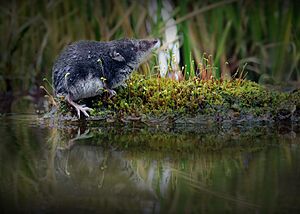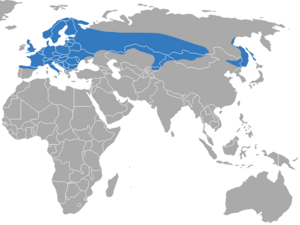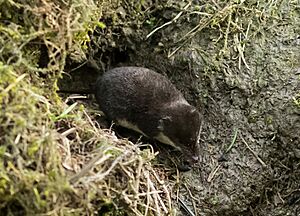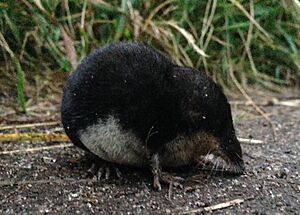Eurasian water shrew facts for kids
Quick facts for kids Eurasian water shrew |
|
|---|---|
 |
|
| Conservation status | |
| Scientific classification | |
| Genus: |
Neomys
|
| Species: |
fodiens
|
 |
|
| Eurasian water shrew range | |
| Synonyms | |
|
Crossopus fodiens Pallas |
|
The Eurasian water shrew is a small, semi-aquatic mammal (meaning it spends a significant part of its life in and around freshwater environments). This remarkable creature plays a big role in its freshwater ecosystems.
Contents
- What Does a Eurasian Water Shrew Look Like?
- Distribution and Habitat: Where Do They Call Home?
- Adaptations: Built for Water!
- The Secret Weapon: Venomous Saliva!
- Life in the Wild: Daily Routines and Family Life
- Hunting and Diet
- Family Life and Reproduction
- Are They in Danger? Conservation Status
- Fast Facts about The Eurasian Water Shrew
What Does a Eurasian Water Shrew Look Like?
The Eurasian water shrew is a sleek and agile animal, perfectly designed for its watery lifestyle. It typically grows to about 10 centimeters (around 4 inches) in length, not including its tail, which can be up to 8 centimeters (about 3 inches) long. When you see one, you'll notice its dense, short fur, which is usually a dark, grayish-black color on its head, back, and sides. This dark fur helps it blend in with its surroundings, especially in the shadows of riverbanks or underwater.
But flip it over, and you'll see a striking contrast! Its belly is a dirty white, sometimes with a hint of rusty brown, and this lighter color is very clearly separated from the darker fur on its back. Occasionally, you might even spot an entirely dark grey individual.
Look closely at its face, and you'll see a small white spot just behind its eye, and often another near its tiny, rounded ear, which is almost hidden by its fur. Its nose is black, and its snout is long and tapering, perfect for poking into crevices and searching for food.
One of the most interesting features of its mouth is its teeth. Like many shrews, its sharp, mostly white teeth have reddish tips. This rusty color comes from tiny deposits of iron, which act like a natural hardening agent, making the enamel incredibly strong, especially on the molars that do most of the chewing. This is super important for an animal that crunches through the shells of insects and snails!
Female water shrews have five pairs of nipples for feeding their litters of young. Their legs are short, but their hind feet are surprisingly powerful. These feet have a special fringe of short, stiff hairs along their outer edge, which act like tiny paddles, helping the shrew propel itself through the water with ease. The tail is slender and has a unique "keel" – a line of short white hairs on the underside – which also helps with steering and balance while swimming.
When they're scurrying about on land, these shrews often make shrill, high-pitched cries, letting others know they're around.
Distribution and Habitat: Where Do They Call Home?
The Eurasian water shrew is a true traveler, found across a vast area of the world! You can find them throughout most of Europe, though they don't live in Iceland, Ireland, some Mediterranean islands, or the Balkans. Their range extends far into Asia, from western Siberia and Asia Minor all the way to North Korea and the Pacific coast of Siberia. That's a huge territory!
As their name suggests, these shrews are never far from water. You'll find them in all sorts of watery places:
- Ditches and Streams: Small, flowing water bodies are perfect for hunting.
- Ponds and Lakes: Still waters provide a rich source of food.
- Watercress Beds and Fish Ponds: These human-made watery areas can also be ideal habitats.
- Damp Meadows and Bushy Ground: Areas with lush vegetation right next to water provide shelter and additional hunting grounds.
They need places where they can easily access water for hunting and also find safe spots on land for nesting and resting. Their presence is often a good sign of a healthy freshwater ecosystem!
Adaptations: Built for Water!
The Eurasian water shrew is a marvel of natural engineering, with several "superpowers" that make it an expert in its watery world:
- Waterproof Fur: One of its most amazing adaptations is its dense, short fur. When the shrew dives into the water, its fur traps tiny bubbles of air. This trapped air acts like a natural wetsuit, keeping its skin dry and providing excellent insulation against the cold water. It also makes the shrew very buoyant, meaning it floats easily. While this buoyancy is great for staying afloat, it also means the shrew has to actively "anchor" itself to the bottom or swim against the current if it wants to stay submerged for more than a quick dive.
- Powerful Paddles: Remember those stiff hairs on its hind feet and the keel on its tail? These aren't just for show! The fringed feet act like tiny paddles, giving the shrew extra thrust as it propels itself through the water. The keel on its tail works like a rudder, helping it steer and maintain balance, allowing for agile movements as it chases prey.
- Underwater Breathing: While it can't breathe underwater like a fish, the air trapped in its fur provides a small, temporary oxygen supply. This allows the shrew to stay submerged for about twenty seconds at a time before it needs to pop back up to the surface for a fresh breath. This is plenty of time for a quick hunt!
- Quick Drying: After a swim, the shrew doesn't stay wet for long. It often heads straight into one of its many burrows. The earth walls of these burrows are excellent at absorbing any moisture clinging to its fur, helping it dry off quickly and stay warm.
These incredible adaptations allow the Eurasian water shrew to be just as comfortable and effective in the water as it is on land.
The Secret Weapon: Venomous Saliva!
Here's one of the most astonishing facts about the Eurasian water shrew: it's one of the very few mammals in the world that has venomous saliva! Yes, you read that right – venomous!
Is it dangerous to humans? Absolutely not! Don't worry, their tiny teeth aren't strong enough to bite through human skin, and their venom isn't dangerous to us. It's a specialized tool for their survival, not a threat to people.
The shrew has a pair of special glands under its jaw that produce this unique venom. This venom is a powerful paralytic peptide, meaning it can cause paralysis. For their prey, however, it's a powerful tool. When the shrew bites a larger insect, a small fish, or even a tiny rodent, the venom quickly acts to immobilize or subdue it. This makes it much easier for the shrew to catch, control, and eat its meal, especially if the prey is struggling. It's like a natural superpower that helps them survive and thrive in their watery world, ensuring they can secure enough food to fuel their incredibly fast metabolism.
This venom is a fantastic example of how animals evolve unique strategies to survive and hunt in their environments.
Life in the Wild: Daily Routines and Family Life
The Eurasian water shrew leads a busy and mostly solitary life, constantly on the move to find food and maintain its territory.
These shrews are active both during the day and at night. They don't have a strict sleep schedule like humans; instead, they have bursts of activity followed by short rests, allowing them to hunt whenever opportunities arise.
Outside of the breeding season, both male and female shrews maintain their own territories. This means they have a specific area they consider their home range, which they defend from other shrews. They generally avoid each other, and there isn't a complex social hierarchy among them.
Hunting and Diet
The water shrew is a skilled hunter, primarily feeding on aquatic organisms. It catches much of its food while swimming, using its keen senses to detect prey. Its diet is quite varied and includes:
- Crayfish and Freshwater Snails: They're not afraid to tackle crustaceans and mollusks.
- Small Fish: Quick and agile, they can snatch small fish from the water.
- Aquatic Larvae and Insects: Many insect larvae live in water and are a staple food source.
- Spiders and Amphibians: They'll also eat spiders and small amphibians like newts.
- Small Rodents: Occasionally, they might catch a small rodent on land.
They also forage on land for things like insect larvae. Studies have shown they prefer smaller invertebrates, which are easier to consume quickly, but they will also eat medium-sized prey like earthworms and beetles, taking more time to eat them.
Home Sweet Home: Eurasian water shrews are excellent burrowers. They either dig their own intricate tunnel systems or use existing burrows made by other animals. Inside, they create a cozy nesting chamber, lining it with soft materials like moss, dry grass, and leaves to keep their young warm and safe.
Family Life and Reproduction
The breeding season for Eurasian water shrews typically runs from April to September. During this time, the males become more nomadic, wandering between different female territories, indicating a mating system where they don't form long-term pairs. Much of their courtship can even happen in the water!
After a gestation period of about twenty-four days (that's less than a month!), the female gives birth to a litter of four to eight, or sometimes even more, tiny and helpless young. At birth, the babies are incredibly small and completely dependent on their mother. Their eyes open when they are about fifteen to eighteen days old, and they are fully weaned (meaning they stop drinking their mother's milk) at around seven weeks of age.
A female can produce two or three litters in a single year, which helps ensure the population continues. Once the juveniles are weaned, they disperse from their birth territory to establish their own, ready to start their independent lives. They become sexually mature quite quickly, at around six to eight months old, and their life expectancy is typically about three years, which is quite long for such a small mammal!
Are They in Danger? Conservation Status
As of 2025, the International Union for Conservation of Nature (IUCN) lists the Eurasian water shrew as being of "Least Concern" in its Red List of Threatened Species. This is good news! It means that, overall, their population is large and spread across a wide range, and it seems to be fairly stable.
However, "Least Concern" doesn't mean they face no challenges. In some areas, their habitats are facing threats:
- Habitat Degradation: Wetlands, which are crucial for water shrews, are sometimes drained for development or agriculture. This reduces the amount of suitable living space for them.
- Pollution: Agricultural products like pesticides and fertilizers, as well as sewage, can pollute waterways. This pollution can harm the shrews directly or reduce the availability of their food sources, like aquatic insects and small fish.
Fast Facts about The Eurasian Water Shrew
- Scientific Name: Neomys fodiens
- Common Names: Eurasian water shrew, water shrew (in the UK)
- Size: Up to 10 cm (4 inches) long, with a tail almost as long!
- Weight: Around 15 to 19 grams (about the weight of a few quarters)
- Habitat: Close to fresh water like streams, ponds, and ditches.
- Diet: Mostly aquatic insects, small fish, snails, and other invertebrates.
- Fast Metabolism: Like many shrews, they have a very high metabolism, meaning they need to eat a lot of food constantly to stay alive. They can't go long without a meal!
- Special Feature: One of the few venomous mammals in the world!
- Bubble Trappers: Their fur is so good at trapping air bubbles that they can look like they're covered in silver when they're underwater!
- Red-Tipped Teeth: Those iron-hardened, red-tipped teeth are a unique feature among mammals, helping them chew through tough prey.




